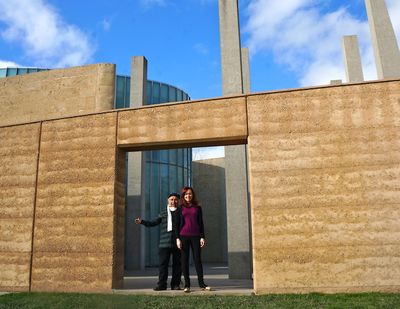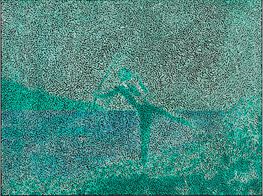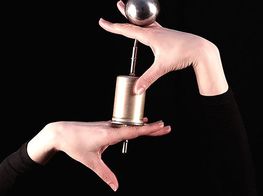Natalie King And Djon Mundine

With the aim of providing an experimental curatorial platform, the TarraWarra Biennial was inaugurated in 2006 to identify new developments in contemporary Australian art.
This year the event is co-curated by independent leading Australian curators—one of Aboriginal descent and the other of non-indigenous descent—Djon Mundine and Natalie King. Located at the TarraWarra Museum of Art in the lush Yarra Valley in Victoria, Australia, the TarraWarra Biennial 2014: Whisper in My Mask, takes its title from the lyrics of Grace Jones' evocative song 'Art Groupie' (1981): Love Me in a Picture, Kiss Me in a Cast, Touch Me in a Sculpture, Whisper in My Mask.
This title reflects a curatorial framework that evokes ideas around masking, secrets and hidden narratives as psychological states. Among the fifty featured artists are Daniel Boyd, boat-people, Søren Dahlgaard, Fiona Hall, Destiny Deacon and Virginia Fraser, Sandra Hill, Gabriella and Silvana Mangano, Romaine Moreton, Nasim Nasr, Fiona Foley, Tony Garifalakis, Polixeni Papapetrou, Elizabeth Pedler, Sangeeta Sandrasegar and the Tjanpi Desert Weavers.
Anna Dickie spoke with King and Mundine about this year's Biennial, the decision to co-curate, its themes, and specific artworks that draw out the ideas of 'masking' and 'whispering'.
ADYou previously worked together when you co-curated the exhibition, Shadowlife. Together, you are co-curating the TarraWarra Biennial also. Tell me about the decision for this Biennial to be co-curated?
NKDjon and I have a history of collaborating. For Shadowlife, we co-curated an exhibition of photographs and moving image works by nine Indigenous and non-Indigenous Australian artists. It was organised in association with Asialink and it toured to Taiwan, Bangkok and Singapore and then concluded at Bendigo Art Gallery. Wungguli, an Arnhem Land word, means sprit and shadow and came to describe the photographic image.
DMBy co-curating we want to break the constraints of various structures and conservative views within the art world. A way to do this is to collaborate and blur age, gender, and of course race—to cross those boundaries and in doing so break the nexus of structural blockages that can otherwise exist. If you can break these, you can bring different traditional ideas and age-old ideas into a contemporary context; you can crossover a lot of boundaries that otherwise might be an impediment to getting artworks together.
ADWere there particular outcomes from your previous collaboration that you felt could be extended here?
NKThe Shadowlife exhibition related to the politics of the day—identity politics, and gender politics as well as nuances of place and belonging. We have tried to weave and extend these concepts into the TarraWarra Biennial.
We are very mindful that TarraWarra is on the outskirts of Melbourne and the word means 'slow moving water' in the local Aboriginal language. It is situated on a hilltop in a verdant valley. We undertook research with the local Aboriginal community to uncover some of the histories of place and in particular Coranderrk, an Aboriginal community that was here in the 1830s.
DMWe tried to uncover the physical nature of the valley. There was a glacial lake in this valley. We are trying to relate to those physical forces and consider how those physical forces impact upon cultural forces.
ADFiona Hall, who is representing Australia at the 2015 Venice Biennale, worked with members of the Tjanpi Desert Weavers on a collaborative work for the Biennial. Can you tell me about that work?
DMFiona Hall, in the context of TarraWarra Biennial, has been working around social issues and issues relevant to endangered species. Here in Australia, our environment is very fragile. There is a famous poem in Australia, by a non-Aboriginal Australian that goes:
I love a sunburnt country.
A land of sweeping plains,
Of rugged mountain ranges,
Of droughts and flooding rains
This is a country that experiences extreme weather condition, no rain for years and then tons of it. Fiona is interested in how we live together in this environment. She works often with grasses and with natural fibers and plants—things that are struggling to survive, some which suddenly flourish and then which disappear. She is working with these materials and dealing with issues of survival: human survival and issues relevant to ensuring the environment doesn't become a wasteland.
NKThe Tjanpi Weaver Project with Fiona Hall was a very exciting new commission that we facilitated for the TarraWarra Biennial. We arranged for Fiona to undertake a camp in Central Australia with twelve members of the Tjanpi Desert Weavers Collective. The camp took place in the bush near Wingellina in Western Australia. Conversations at camp coalesced around the notion of camouflage, a term with no literal translation in Pitjantjatjara, but conceptualised to relate to disguise, hide or deceive. They set up, through an interpreter, some parameters to explore their habitat and endangered species. There was an exchange of materials and an exchange of attitude and thinking.
DMA little known history outside of this place is that the British used this site as a testing site for their atomic bombs—at Maralinga and this testing resulted in a number of aboriginal people dying—they weren't warned about the testing, or didn't understand it.
ADMany of the works in the Biennial have quite strong political overtones. In particular, work presented by the boat-people. Can we please discuss their work?
NKThe boat-people are a collaborative group. We wanted to work with artists who were working collaboratively, as well as those working on their own. The boat-people stage activist, public events where members shroud their faces in flags as a gesture of protest.
DMThe boat-people very much draw attention to the way that certain politicians—and not just in Australia, but in many other places—talk about refugees. One of the ways they discuss refugees who come by boat is to link their arrival to a type of 'invasion'. They liken it to a type of 'war' situation.
When people come to this country, they come by boat and they also come by plane. The backpackers who come to Australia each year and stay on: they come by airplane. Somehow those people who come by airplane are not seen in the same way as those who come by boat. While the boat people are treated like "invaders", the backpackers are not. The strategy to stop people landing by boat is actually called by the local government, 'Operation Stop the Boats'. Describing it like this sets the tone of a 'military operation'. We see people take this issue and wrap themselves in the flag of nationalism—suggesting that to tackle this issue is akin to 'defending' the country.
NKWe wanted to introduce this type of political intensity. Equally, other works are less political and are more playful or poetic or lyrical. We wanted these mood shifts within the Biennial to incite and entice viewers.
ADThe theme of masking is essential to the Biennial. Perhaps we can discuss how this theme manifests in other works, but in different ways?
NKWe are interested in exploring a variety of media and approaches to the issues of masking. Sangeeta Sandrasegar's work is very delicate, for example; she uses paper-cut outs rendered with a scalpel. She looks at Malaysian folklore ghost stories and excavates these ancient narratives. Often there is a female protagonist. In comparison, someone like Søren Dahlgaard has produced dough portraits that he has done around the world in different situations, exploring the notion of 'place'. We staged a dough portrait session at TarraWarra and a crowd came here and people draped the dough on their head and he took their portraits—it was very much a live art event.
Dough is something used by every community, and this event also allowed us to be inclusive of the community—something we value.
DMThe Biennial theme is about thinking about things that are masked—things that are behind a wall or a barrier—things you cannot see clearly: people mask their personality, and likewise history or society is obscured. To see the personality of the person, or the personality of the society or the personality of the history of the place—that is the aim.
ADAnd how does the idea of 'whispering', which is referenced in the Biennial's title, relate to 'masking'?
NKThe whole idea of the title and reference to the mask is very much about an evocation, a trigger. The title is derived from lyrics from a Grace Jones song called Art Groupie (1981) that is suggestive of emotive responses. So some works literally are masks, but others are different kinds of evocations. The whole idea of 'whispering' was of interest to us because it represents an utterance, something that is spoken softly. To whisper is an intimate act, and another kind of thread throughout the Biennial.
DMPeople might have a formal persona, but whispering is the thread behind the mask—it's the other story.
ADCan we please discuss the work by Daniel Boyd in the Biennial?
DMDaniel Boyd is actually of Vanuatu descent, and also of Aboriginal heritage. There is a history here of Vanuatu people being bought to Australia as a form of indentured or basic slave labour. His work talks about landscape and considers the society of people within that landscape.
Physicists tell us there is four times the amount of material in the universe that doesn't reflect light. He talks about looking at the dark matter of the universe—looking beyond the dark matter—looking beyond the obvious physical landscape to the social and cultural landscape. Boyd uses historical photographs to create a series of paintings that force us to look at the dark matter, not at the light.
NKDaniel Boyd has re-visited the historical photographs from the 1870s of the Aboriginal community at Coranderrk by Fred Kruger. He has overlaid a matrix of dots over these historical images so the past is submerged and obliterated, but there is also a reference to Aboriginal dot painting. He has made two large new paintings for the Biennial, based on the photographs from the 1870s.
Daniel has also created an installation for the Biennial, which is situated in the TarraWarra Museum. The Museum has a very long spine, with a window at the end that looks out onto an incredible landscape vista, and he has covered this window with vinyl that has perforations through it, as if he is putting a screen of dots onto the window and it changes the vista into a celestial galaxy.
DMHe has created a type of stenopeic lens that makes you focus on particular things. He covers the window so you look out at the real landscape.
ADYou also included a film work by Nasim Nasr. Can we please discuss this work?
NKWe are interested in the nexus between visual, performing art and cinema.
Nasim Nasr is an emerging artist, who is Iranian, but now based in Adelaide. We are showing three of her works. One of these works, Erasure, is a two channel video that depicts a woman wearing a black burka and in one channel she is writing a poem in chalk on a board, and in the other that poem is being erased. It has a very poetic quality. In her work Unveiling the Veil, we see a close up of the artist's eyes and she starts to weep. It is a very emotional work, a sort of lament.
ADThe emotion of this works contrasts with other works that appear more lighthearted. Polixeni Papapetrou for example—her work appears very theatrical.
NKPolixeni is a Melbourne based artist of Greek descent and she nearly always photographs her subjects in different guises. In this particular work she has been sourcing vintage clown costumes. She is interested in the idea of what the clown represents and in the emotional layers of a clown. She has dressed her own children in the clown clothes for these works. The children are in fact adolescent, but you don't get a sense of who they are or what is behind the masks. She uses poignant titles: Melancholia, Grief, Sorrow: like the seven stage of grieving.
DMI also feel there is a link to the puppets, Punch and Judy. In many ways, these puppets in their often violent, pantomime actions represent how people often disguise things they want to express, but cannot express. The puppets enabled such frustrations to be played out in a different form—a different veil.
ADWhat next?
DMI have a minor exhibition called Girls in our Town, which opens in November and the title references a famous song in Australia written by Bob Hudson. The song refers to these girls who live in country towns and never fulfill their potential. It is a sad story and named one of the ten most political songs in Australia. I am also working on another show about an aboriginal male artist, called Robert Campbell Junior who made political painting in the eighties and nineties and died at age 50. Fifty is the life expectancy of male aboriginals, and he didn't beat that. He is having a major retrospective.
NKI am working as Senior Curator on a temporary architectural pavilion in Melbourne's Queen Victoria Gardens in an arts precinct in downtown Melbourne. MPavilion is initiated by the Naomi Milgrom Foundation and is partly inspired by the Serpentine pavilions in London. This temporary structure, designed by Sean Godsell, has taken up residence in parklands for the peak summer months. I have curated a series of interventions called One Night Stand, exploring what might take place after dark outside of institutional hours whether fleeting romance, nocturnal liaisons or sonic lullabies. Slow Art Collective, The Telepathy Project and Monash University are creating communal spaces for wandering, dreaming, talking, pondering and star-gazing. —[O]
ADARTISTS INVOLVED:
The Biennial includes the work of: boat-people (Safdar Ahmed, Zehra Ahmed, Stephanie Carrick, Dave Gravina, Katie Hepworth, Jiann Hughes, Deborah Kelly, Enda Murray, Pip Shea, Sumugan Sivanesan, Jamil Yamani) (NSW), Daniel Boyd (NSW), Søren Dahlgaard (VIC), Destiny Deacon & Virginia Fraser (VIC), Karla Dickens (NSW), Fiona Foley (QLD), Tony Garifalakis (VIC), Sandra Hill (WA), Gabriella Mangano and Silvana Mangano (VIC), Romaine Moreton (VIC), Nasim Nasr (SA), Polixeni Papapetrou (VIC), Elizabeth Pedler (WA), Sangeeta Sandrasegar (VIC), The Telepathy Project (Veronica Kent and Sean Peoples) (VIC) and The Tjanpi Desert Weavers Project with Fiona Hall (SA/NT/WA).
ADBIOGRAPHIES OF CURATORS:
Djon Mundine is an independent curator, art historian and activist. He is most well known for commissioning and instigating the installation of 200 hollow log coffins created by Arnhem Land artists that commemorates the losses sustained by Indigenous people in the wake of colonisation, and is now permanently displayed at the National Gallery of Australia. In 1995, Mundine was awarded an Order of Australia Medal (OAM) for service to the visual arts. Mundine is widely published and has worked for numerous respected institutions including the MCA, AGNSW and Campbell-town Arts Centre, where he worked from 2006-2009 as Indigenous Curator of Contemporary Art. Together with Natalie King, Mundine co-curated Shadowlife, an exhibition of works by nine internationally renowned contemporary Australian Aboriginal artists (and one non-Indigenous collaborator) engaged in photo-based practices that toured to Thailand, Taiwan, Singapore, and finally to Bendigo Art Gallery.
Natalie King is Senior Curator of MPavilion and Senior Research Fellow at the Victorian College of the Arts, University of Melbourne. In addition to Shadowlife and this year's TarraWarra Biennial, she has previously curated exhibitions for the Tokyo Metropolitan Museum of Photography; National Museum of Art, Osaka; MCA, Sydney; Tjibaou Cultural Centre, New Caledonia and Singapore Art Museum. She is a correspondent for 'Flash Art' and on the editorial board of Art and Australia. She has recently also co-curated Episodes: Australian Photography Now, which was presented as part of the Dong Gang International Photo Festival in Yeongwol, Korea earlier this year.
TarraWarra Biennial 2014: Whisper in My Mask, TarraWarra Museum of Art, Healesville, 16 August — 16 November 2014.













